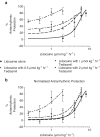Tedisamil and lidocaine enhance each other's antiarrhythmic activity against ischaemia-induced arrhythmias in rats
- PMID: 12922925
- PMCID: PMC1573972
- DOI: 10.1038/sj.bjp.0705373
Tedisamil and lidocaine enhance each other's antiarrhythmic activity against ischaemia-induced arrhythmias in rats
Abstract
1. Combinations of the action potential-widening drug tedisamil (Class III antiarrhythmic activity), and the inactivated state sodium channel blocker lidocaine (Class Ib antiarrhythmic activity) were assessed for antiarrhythmic actions in a rat model of ischaemia-induced arrhythmias and for electrophysiological actions in normal rat myocardial tissue. 2. Both tedisamil and lidocaine dose-dependently suppressed ischaemia-induced arrhythmias. The ED(50) values were 3.0+/-1.3 and 4.9+/-0.6 micro mol kg(-1) min(-1), respectively. 3. Combinations of the two drugs acted synergistically such that the ED(50) for tedisamil was reduced to 0.8+/-0.2 micro mol kg(-1) min(-1) in the presence of 2 micro mol kg(-1) min(-1) lidocaine. Similarly, the ED(50) for lidocaine was reduced to 0.7+/-0.2 micro mol kg(-1) min(-1) in the presence of 2 micro mol kg(-1) min(-1) tedisamil (both P<0.05). 4. In a separate series of experiments in which normal ventricular tissue was electrically stimulated, 2 micro mol kg(-1) min(-1) lidocaine produced a leftward shift in the dose-response curve for tedisamil's effect on effective refractory period (P<0.05). This dose of lidocaine had no effect on its own. These data indicate that the synergistic actions of combinations of tedisamil and lidocaine were mediated, at least in part, by extension of effective refractory period in normal myocardial tissue. 5. In contrast to the strategy of developing drugs that are selective for a single electrophysiological mechanism, the results of the present study suggest that effective antiarrhythmic drugs might be developed by optimising the combination of two complimentary electrophysiological mechanisms (i.e., action potential-prolonging activity and inactivated state sodium channel blockade).
Figures





Similar articles
-
KC8851, a tedisamil analogue with mixed channel blockade, exhibits antiarrhythmic properties against ischemia- and electrically-induced arrhythmias.Life Sci. 1997;61(3):237-48. doi: 10.1016/s0024-3205(97)00379-2. Life Sci. 1997. PMID: 9217283
-
Antiarrhythmic properties of tedisamil (KC8857), a putative transient outward K+ current blocker.Br J Pharmacol. 1991 Jan;102(1):13-8. doi: 10.1111/j.1476-5381.1991.tb12124.x. Br J Pharmacol. 1991. PMID: 2043919 Free PMC article.
-
RSD1019 suppresses ischaemia-induced monophasic action potential shortening and arrhythmias in anaesthetized rabbits.Br J Pharmacol. 2000 Oct;131(3):405-14. doi: 10.1038/sj.bjp.0703592. Br J Pharmacol. 2000. PMID: 11015289 Free PMC article.
-
Novel antiarrhythmic drugs in atrial fibrillation: focus on tedisamil.Expert Opin Investig Drugs. 2009 Aug;18(8):1191-6. doi: 10.1517/13543780903114150. Expert Opin Investig Drugs. 2009. PMID: 19604120 Review.
-
Tedisamil: master switch of nature?Expert Opin Investig Drugs. 2001 Jan;10(1):129-38. doi: 10.1517/13543784.10.1.129. Expert Opin Investig Drugs. 2001. PMID: 11116286 Review.
Cited by
-
Antiarrhythmic drug research.Br J Pharmacol. 2006 Jan;147 Suppl 1(Suppl 1):S222-31. doi: 10.1038/sj.bjp.0706500. Br J Pharmacol. 2006. PMID: 16402108 Free PMC article.
References
-
- ADAIKAN G., BEATCH G.N., LEE T.L., RATNAM S.S., WALKER M.J.A. Antiarrhythmic actions of tedisamil: studies in rats and primates. Cardiovasc. Drugs Ther. 1992;6:345–352.
-
- ABRAHAM S., BEATCH G.N., MACLEOD B.A., WALKER M.J.A. Antiarrhythmic properties of tetrodotoxin against occlusion-induced arrhythmias in the rat: a novel approach to the study of the antiarrhythmic effects of ventricular sodium channel blockade. J. Pharmacol. Exp. Ther. 1989;251:1166–1173. - PubMed
-
- ASSIMES T.L., MALCOLM I. Torsades de pointes with sotalol overdose treated successfully with lidocaine. Can. J. Cardiol. 1998;14:753–756. - PubMed
-
- BARRETT T.D., HAYES E.S., WALKER M.J.A. Lack of selectivity for ventricular and ischaemic tissue limits the antiarrhythmic actions of lidocaine, quinidine and flecainide against ischaemia-induced arrhythmias. Eur. J. Pharmacol. 1995;285:229–238. - PubMed
Publication types
MeSH terms
Substances
LinkOut - more resources
Full Text Sources
Medical
Miscellaneous

